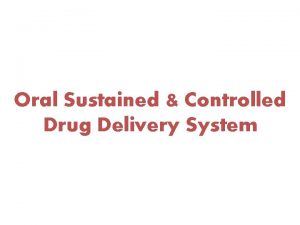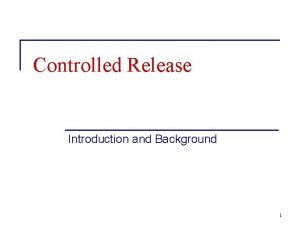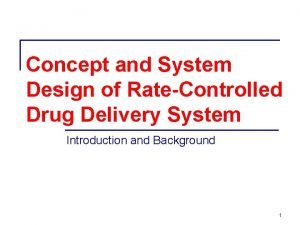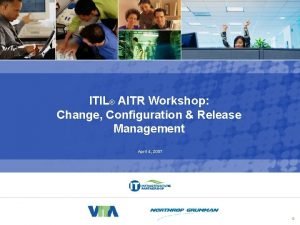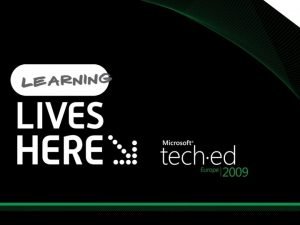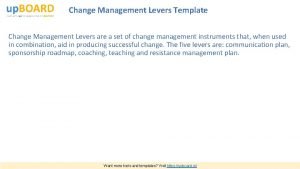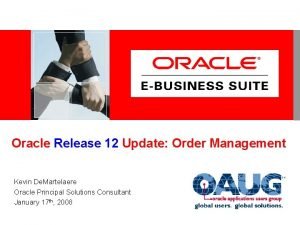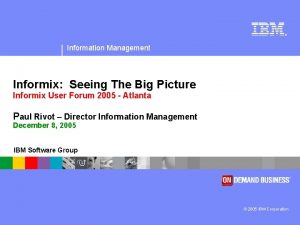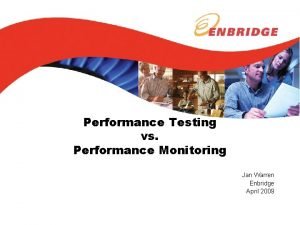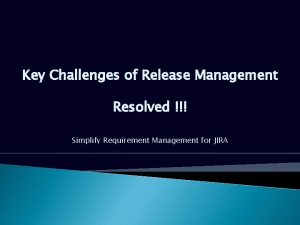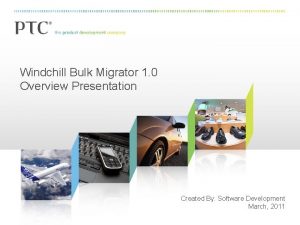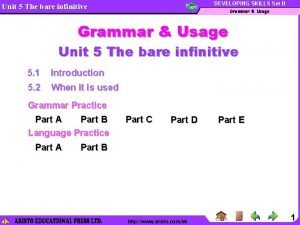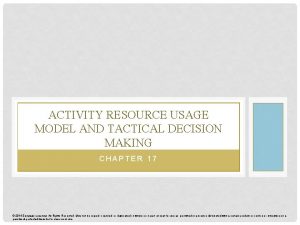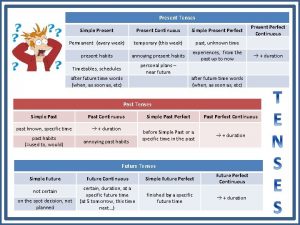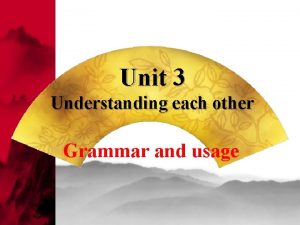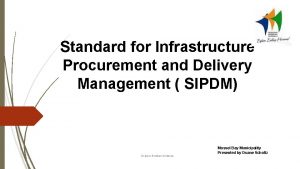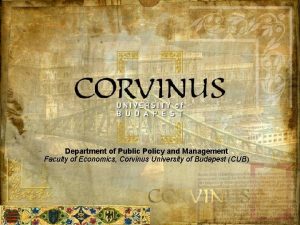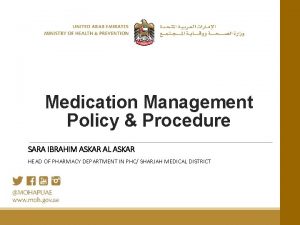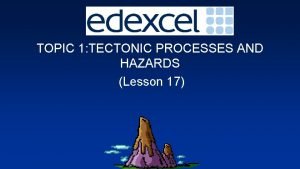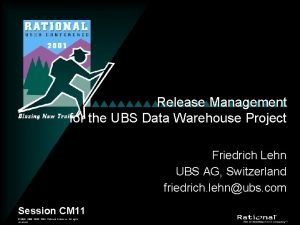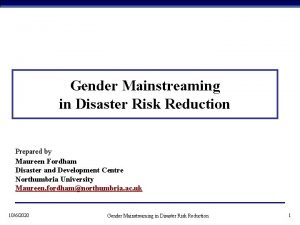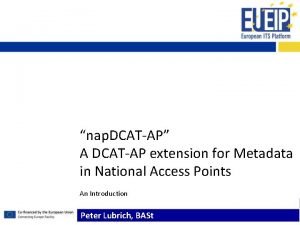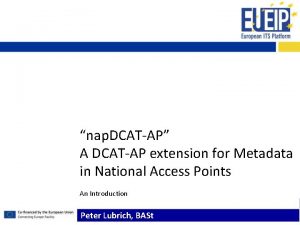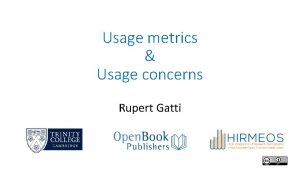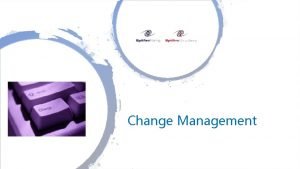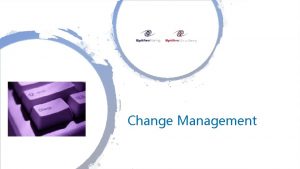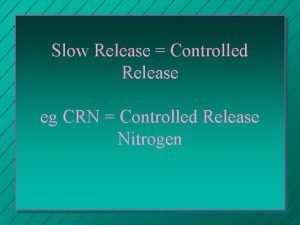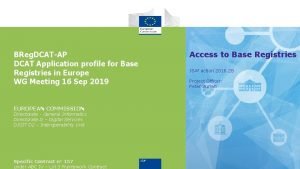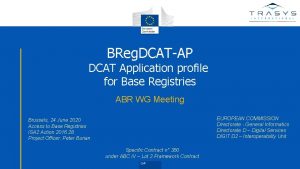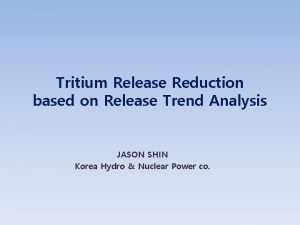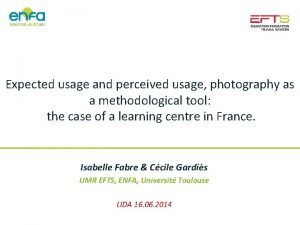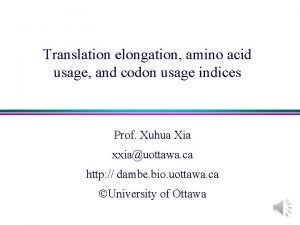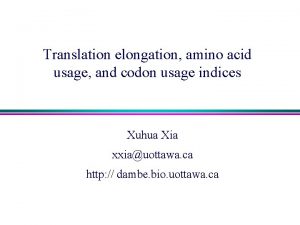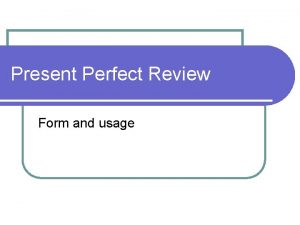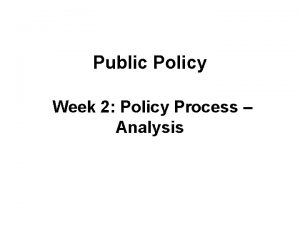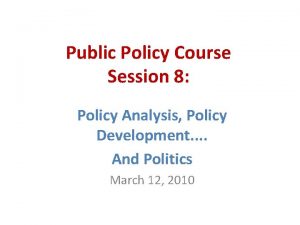DCATAP CHANGE AND RELEASE MANAGEMENT POLICY USAGE ANALYSIS



































- Slides: 35

DCAT-AP CHANGE AND RELEASE MANAGEMENT POLICY & USAGE ANALYSIS 8 DECEMBER 2017 ISA² ACTION 2016. 07: PROMOTING SEMANTIC INTEROPERABILITY AMONG EU MEMBER STATES

TOPICS OF TODAY 1. Opening 2. Presentation of the Change and Release Management Policy 3. Presentation of results of DCAT-AP usage analysis 4. Discussion of initial set of change requests 5. W 3 C Data Exchange Working Group (DXWG) 6. Next steps 2

OPENING | TOUR DE TABLE 3

Change & Release management policy for DCAT-AP

REMINDER - OBJECTIVES OF THE WORK Objective: Update the change and release management policy for DCAT-AP Rationale: • Need for a transparent, well-managed and predictable change process • Avoid disruption in the interoperability across data portals • Allow flexibility to make changes based on evolving needs and external events: • DCAT-AP will be further developed to meet changing needs • DCAT is being updated by W 3 C’s DXWG 5

THE CHANGE & RELEASE MANAGEMENT POLICY WHAT & WHEN • Bug fixes – every 6 months* Correction of errors or unresolved references. No effect on interoperability. • Minor semantic changes – yearly* Changes that may affect interoperability in non-disruptive ways. E. g. addition of optional properties or deprecation of unused, optional properties. • Major semantic changes – every 2 years* or following W 3 C Changes that have more serious consequences for interoperability, such as addition of mandatory properties or changes in the mandatory controlled vocabularies. 6

THE CHANGE & RELEASE MANAGEMENT POLICY WHAT & WHEN • At least eight months before a scheduled date for a major release, a decision is taken by the ISA² Programme Management Team and communicated to the Working Group to open a discussion round in the Working Group in order to discuss and agree major semantic changes. • Evolution of the W 3 C Recommendation could lead to the need for major semantic changes. Whenever W 3 C plans to publish a new version of DCAT, it may be foreseen that the process towards a major semantic release will be scheduled to enable the Working Group to review W 3 C work and determine implications for DCAT-AP. 7

THE CHANGE & RELEASE MANAGEMENT POLICY PROCESS FOR CHANGE REQUESTS – 24 MONTHS Month 1 2 3 4 5 6 7 8 9 10 11 12 1 2 3 Publication 4 5 6 7 8 9 Publication 10 11 12 Publication Bug fix Closing 1 m change requests 2 w WG Informed Publication Minor Closing change requests 3 m WG Review Closing change requests 6 w 3 m WG Review 6 w Publication Major Closing change requests WG Discuss & Agree Report 8 m ≥ 3 m ≥ 1 m 1 m Public Review WG Review & Reso 8

THE CHANGE & RELEASE MANAGEMENT POLICY STAKEHOLDER INVOLVEMENT All stakeholders are invited to become member of the DCAT-AP Working Group: • maintainers of national and regional application profiles; • developers of solutions that implement DCAT-AP; and • managers of systems that are built on the functionality of DCAT-AP implementations. Become a member via Joinup 9

THE CHANGE & RELEASE MANAGEMENT POLICY ROLE OF THE WORKING GROUP Bug fixessubmit change requests until 1 month ahead of publication WG is informed 2 weeks ahead of publication and can raise Minor objections submit change requests until 3 months before publication semantic WG is informed 6 weeks ahead of publication for review changes Major submit change requests until 8 months before publication semantic discuss and agree on changes during a period of at least 3 changes months participate in the public review of at least 1 month 10 review and resolve issues raised during the last month before

THE CHANGE & RELEASE MANAGEMENT POLICY PROCESS FOR CHANGE REQUESTS • Problems & requests can be submitted via Git. Hub: https: //github. com/SEMICeu/DCAT-AP • Name, affiliation, portal, clear description of the requirement and proposed solution should be mentioned. • The editor (European Commission contractor’s team) classifies issues, schedules their processing and replies within two weeks. • At least every 3 months, the editor prepares a status report for the DCAT-AP Working Group with an overview of change requests received in each of the three categories: bug fix, minor or major semantic change. 11

THE CHANGE & RELEASE MANAGEMENT POLICY IMPLICATIONS FOR IMPLEMENTERS • Bug fixes: no implications • Minor semantic changes: no immediate implementation needed, existing implementations remain conformant. • Major semantic changes: no backward compatibility guaranteed, introduction of a release needs to be accompanied by a wellmanaged software upgrade process. SUGGESTED PRACTICE • Indicate which version you have implemented • Include upgrades to newer versions in your release planning 12

THE CHANGE & RELEASE MANAGEMENT POLICY RELEASE DOCUMENTATION • Specification: PDF, DOCX & ODT • UML diagram: PNG/JPG, SVG & XMI • Machine-readable distributions: RDF, JSON-LD and SHACL/OWL • Decision log • Change log POLICY REVIEW The change and release management policy will be reviewed by the European Commission every two years. The next review is scheduled to take place in second half of 2019. 13

WHERE ARE WE IN THE RELEASE CYCLE? TIMELINE • We’re in a pre-cycle period: first upcoming cycle: bug fix release for publication May 2018 • In the meantime: gathering change requests for all categories on Git. Hub • Planning future releases: minor semantic changes November 2018, major semantic changes in 2019 ROLE OF THE WORKING GROUP • Contribute change requests on https: //github. com/SEMICeu/DCATGit. Hub AP • Participate in discussion on Git. Hub 14

DCAT-AP usage analysis

OBJECTIVES OF THE ANALYSIS Objective: Assess the usage of DCAT-AP on the European Data Portal to propose recommendations to the DCAT-AP working group. Rationale: • Analyse how DCAT-AP is used in practice to identify changing needs • Use SPARQL queries to collect information about the DCAT-AP classes and properties present on the EDP • The European Data Portal is harvesting 73 catalogues in Europe with 788, 671 datasets, representing the biggest single source of information compliant with the DCAT-AP. 16

Statistics: And specific queries: 17

DCAT: CATALOG dcat: theme. Taxonomy • Usage: 100% of the catalogues queried by the European Data Portal • Should this property be made mandatory? dct: spatial • Usage: 83. 75% with almost all countries represented • Should this property be made recommended? dct: language, dct: rights, dct: is. Part. Of and dct: has. Part • Usage: 0% • Should these properties be removed/withdrawn/deprecated? 18

DCAT: DATASET dct: description • Usage: 96. 46% of the datasets queried • Should we somehow encourage addition of description to the 26, 328 datasets that don’t use this mandatory property? dct: publisher and dcat: contact. Point • Usage: 43. 85% and 45. 44% respectively; 5. 2% use both properties • How could we promote the usage of these recommended properties, in addition to the guideline “How are publisher and contact point modelled”? . 19

DCAT: DATASET dct: spatial • Usage: 76. 79% • Should this property be made recommended? adms: sample, adms: version. Notes, dct: access. Rights, dct: has. Version, dct: is. Version. Of, dct: relation, dct: source, dct: type, owl: version. Info • Usage: 0% • Should these properties be removed/withdrawn/deprecated? 20

DCAT: DATASET dct: accrual. Periodicity • Usage: 44. 98% • Issue: some datasets are using the URIs of the MDR Frequencies NAL while other datasets use the label of the same authority list. • Example: IRREG and IRREGULAR at http: //publications. europa. eu/mdr/resource/authority/frequency/ht ml/frequencies-eng. html • Is there a need for guidelines to harmonise usage across implementations? 21

DCAT: DISTRIBUTION dct: title and dct: format • Usage: 77. 17% and 12. 17% respectively • Issue: Some distributions use dct: title instead of dct: format to provide information about the format of the distribution. • Is there a need for guidelines to explain how to use dct: title and dct: format? dct: rights, dcat: byte. Size, dct: language, spdx: checksum, dct: conforms. To • Usage: near-zero % • Should these properties be removed/withdrawn/deprecated? 22

DCAT: DISTRIBUTION dct: format and dcat: media. Type • Usage: 12. 17% and 25. 52% respectively • Issue: dct: format is a recommended property but Distributions use the optional property dcat: media. Type, which is more restrictive (IANA media type). • Is there a need for guidelines explaining how to use dct: format and dcat: media. Type similar to guideline “How to use access. URL and download. URL? ”, e. g. if specific media type(s) can be provided, duplicate value of the media type(s) in both dcat: media. Type and dct: format? adms: sample, foaf: page • Usage: 0% • Should these properties be removed/withdrawn/deprecated? 23

DCAT: CATALOGRECORD dct: conforms. To, dct: title, dct: source, dct: language, dct: description • Usage: 0% • Should these properties be removed/withdrawn/deprecated? 24

OTHER CHANGE REQUESTS • Cardinality dct: type on Licence Document • Currently set to max 1 • More than one concept from ADMS licence types controlled vocabulary can apply • Should we consider to increase cardinality to 0…n? • Longer term: should we discuss other approaches to licence types, e. g. Open Digital Rights Language (ODRL), Creative Commons CC REL? 25

DISCUSSION ON CHANGE REQUESTS • All change requests are managed on Git. Hub at https: //github. com/SEMICeu/DCAT-AP • Discussion will take place on Git. Hub, publicly visible • DCAT-AP Working Group members are invited to contribute new change requests and comment on existing change requests • DCAT-AP Editor to report on status and progress in March 2018 26

W 3 C Data Exchange Working Group (DXWG)

W 3 C DATA EXCHANGE WORKING GROUP (DXWG) INTENDED OUTCOMES • DCAT 1. 1 An update and expansion of the current DCAT Recommendation. The new version may deprecate, but MUST NOT delete, any existing terms. • Guidance on publishing application profiles of vocabularies A definition of what is meant by an application profile and an explanation of one or more methods for publishing and sharing them. • Content Negotiation by Application Profile An explanation of how to implement the expected RFC and suitable fall-back mechanisms as discussed at the SDSVoc workshop. 28

W 3 C DATA EXCHANGE WORKING GROUP (DXWG) SOME RELEVANT DISCUSSIONS SO FAR • Versioning Initial agreement not to prescribe what a version is, but make sure that DCAT can describe various types of versioning relationships • Differences between Distributions Consensus that all Distributions of a Dataset should be 'informationally equivalent' • Granularity and combination of profiles Including a profile into another, e. g. v. Card profile for contact point in DCAT-AP • ‘Extension points’ for other vocabularies Combining DCAT with vocabularies for provenance, data quality, service descriptions but not include those in specification of DCAT itself 29

W 3 C DATA EXCHANGE WORKING GROUP (DXWG) PARTICIPANTS • Chairs Karen Coyle, Dublin Core Metadata Initiative (DCMI) Caroline Burle, Brazilian Network Information Center (NIC. br) • Editors: Use Cases and Requirements: Ixchel Faniel (OCLC), Jaroslav Pullmann (Fraunhofer), Rob Atkinson (Metalinkage/Open Geospatial Consortium DCAT: Alejandra González Beltrán (U. Oxford e. Research Centre), Dave Browning (Thomson Reuters), Simon Cox (CSIRO), Peter Winstanley (Scottish Government) • W 3 C team contact: Dave Raggett (replaced Phil Archer) 30

W 3 C DATA EXCHANGE WORKING GROUP (DXWG) CURRENT STATUS • First Public Working Draft “Use Cases and Requirements” ready for publication December 2017 • Sub-group for DCAT 1. 1 established; • Profiles sub-group being set up FURTHER PLANNING • First Public Working Drafts DCAT 1. 1 and Profile Negotiation 1 st Quarter 2018 • Candidate Recommendations 4 th Quarter 2018 31

NEXT STEPS

TIMELINE NEXT 6 MONTHS • December 2017 – Publish DCAT-AP usage analysis • December 2017 to early April 2018 – Gather change requests from Working Group • Early April 2018 – Close change requests for bug fixes, if such change requests were introduced • Mid-April 2018 – Inform the WG • Late April/early May 2018 – Publish the new release, if necessary Submitted change requests for semantic changes will be retained for next minor semantic release (November 2018) or major semantic release (November 2019) 33

Promoting semantic interoperability in Europe STAY CONNECTED! PROJECT OFFICERS Susanne. Wigard@ec. europa. eu Fidel. Santiago@ec. europa. eu GET INVOLVED § § § Follow @SEMICeu on Twitter Join the SEMIC group on Linkedin Join the SEMIC community on Joinup VISIT OUR INITIATIVES

DOCUMENT METADATA Disclaimer The views expressed in this report are purely those of the authors and may not, in any circumstances, be interpreted as stating an official position of the European Commission. The European Commission does not guarantee the accuracy of the information included in this study, nor does it accept any responsibility for any use thereof. Reference herein to any specific products, specifications, process, or service by trade name, trademark, manufacturer, or otherwise, does not necessarily constitute or imply its endorsement, recommendation, or favouring by the European Commission. All care has been taken by the author to ensure that s/he has obtained, where necessary, permission to use any parts of manuscripts including illustrations, maps, and graphs, on which intellectual property rights already exist from the titular holder(s) of such rights or from her/his or their legal representative. Version: 1. 0 Publication date: 7 December 2017 Created by: Brecht Wyns, Florian Barthelemy [Pw. C EU Services] Makx Dekkers [AMI Consult] Reviewed by: Fidel Santiago [ISA² Programme, European Commission] 35
 Difference between sustained release and controlled release
Difference between sustained release and controlled release Ocusert definition
Ocusert definition Extended release vs sustained release
Extended release vs sustained release Change configuration & release management
Change configuration & release management Advanced group policy management
Advanced group policy management Change management proposal template
Change management proposal template Oracle update with order by
Oracle update with order by Informix release management
Informix release management Release management itil
Release management itil Release management challenges
Release management challenges Tfs 2013 agile portfolio management
Tfs 2013 agile portfolio management Windchill bulk migrator installation and usage guide
Windchill bulk migrator installation and usage guide Developing skills grammar & usage
Developing skills grammar & usage Give two piece of advice to avoid computer addiction
Give two piece of advice to avoid computer addiction Activity resource usage model and tactical decision making
Activity resource usage model and tactical decision making Activity resource usage model and tactical decision making
Activity resource usage model and tactical decision making Present simple perfect
Present simple perfect Unit 3 grammar and usage
Unit 3 grammar and usage We should or we must
We should or we must Unit 3 grammar and usage
Unit 3 grammar and usage Les appositions
Les appositions Examples of physical change
Examples of physical change Absolute change and relative change formula
Absolute change and relative change formula Difference between chemical and physical change
Difference between chemical and physical change Supply and demand curve shifts
Supply and demand curve shifts What is a physical change
What is a physical change Rocks change due to temperature and pressure change
Rocks change due to temperature and pressure change Physical change and chemical change venn diagram
Physical change and chemical change venn diagram First-order change and second-order change examples
First-order change and second-order change examples Siodm
Siodm Public policy and management corvinus
Public policy and management corvinus Medication management policy and procedure
Medication management policy and procedure Pressure and release model
Pressure and release model Release manager responsibilities
Release manager responsibilities Pressure and release model
Pressure and release model Experimental study of hydrogen release and ignition from
Experimental study of hydrogen release and ignition from
